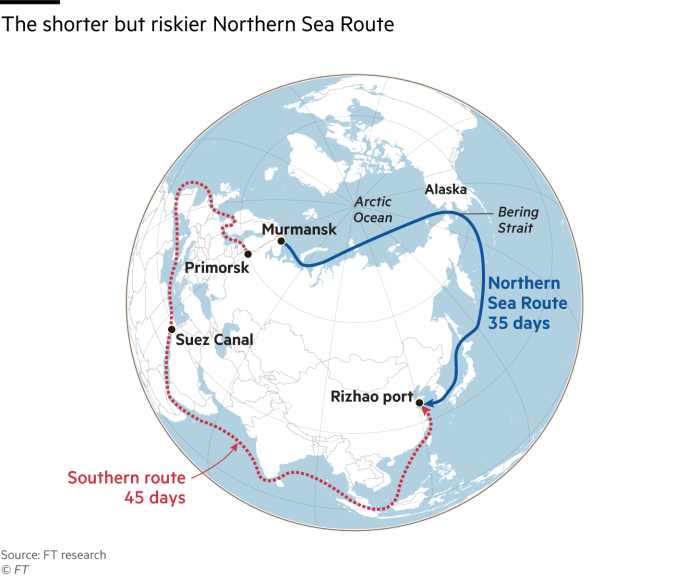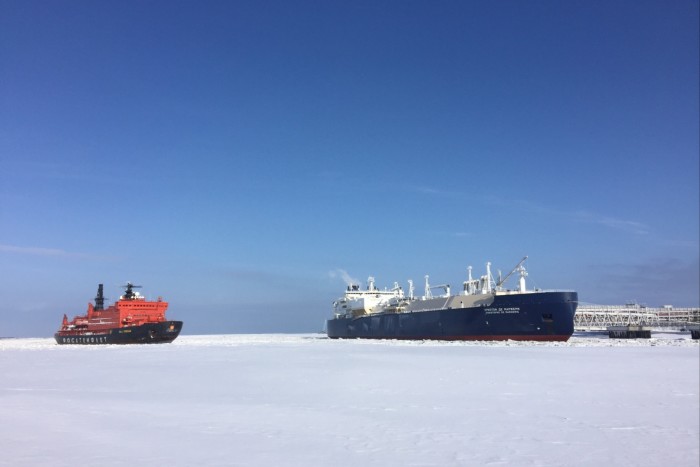Russia has authorised unreinforced oil tankers to sail through its icy Northern Sea Route for the first time, triggering warnings Moscow is risking a catastrophic Arctic spill as it reroutes sanctions-hit energy exports to Asia.
Two tankers were granted permission in August to carry out the 3,500-mile long journey along Russia’s northern coast, despite not being so-called “ice class” tankers that are strengthened to withstand icier conditions.
The thin-hulled vessels sailed for China in early September, navigating one of the most dangerous ice passages on the planet for the first time, far from any capabilities to respond to oil spills.
“Sea ice is unpredictable and routes are very hard to maintain,” said Charlie Kronick at Greenpeace UK. “Using non-ice-class tankers makes the already high likelihood of an accident that much worse.”
Moscow has in recent years hailed the Northern Sea Route, which lies entirely within the Arctic waters, as offering a shorter shipping route to China. A warming climate has opened up the route in summer months, which is far quicker than sailing the normal way via the Suez Canal.

The move to authorise non-ice class tankers on the route comes as western sanctions related to Russia’s invasion of Ukraine have hurt Moscow’s ability to bring its oil to market. It has already been using the Northern Sea Route more frequently to cut the time to sail to Asian markets.
A typical journey from the northern Russian port of Primorsk to China via the Suez Canal takes 45 days; using the northern sea route trims it by 10 days. Russia could save an estimated half a million dollars per voyage solely on fuel, said Viktor Katona, a lead crude analyst at Kpler.
In 2022, only one tanker, the heavily reinforced Vasily Dinkov, carried Russian crude oil via this route to China. In 2023, however, 10 ice-class tankers have headed to China, according to ship tracking data from Kpler. One reinforced LNG tanker also completed the journey this week.
The use of unreinforced vessels has potentially been possible on the route since 2020. Rosatom, the Russian agency which regulates the Northern Sea Route, allowed non-ice-class vessels to sail the route in a summer-autumn window from July to mid-November independently or, in lighter icy conditions, with an icebreaker escort.
Rosatom told the FT that “the improved navigation conditions in the summer and autumn months allow non-ice-class ships to operate safely,” adding that all the vessels were subject to rigorous inspections. It said environmental considerations “have always been and remain Rosatom’s top priority”.
Shipping experts said that unreinforced tankers could in theory navigate the Northern Sea Route during September and October, when the ice pack is at its thinnest following the warm summer months. But there remain large risks as ice floes can trap vessels and potentially crush non-reinforced hulls.
Sigurd Enge, a senior advisor on shipping and Arctic Issues at Bellona environmental group, said the risk was “quite extreme . . . A summer day on the northern route is not necessarily an easy ride.”

Ice movement there, driven by both sea currents and wind, is highly unpredictable. When there is less ice, waves can also be higher, posing other risks.
In late July this year, several ice-class ships faced sea ice more challenging than their ice classification allowed and had to wait for icebreaker escorts in the East Siberian Sea.
Malte Humpert, a reporter with publication High North News that specialises in Arctic coverage, said the shipments showed Russia’s “desperation” to sell its oil.
“I think it’s a clear sign that for Russia selling its energy at any cost trumps the environment,” said Humpert, who first reported on the use of one tanker, the Leonid Loza.
“The nexus of climate change and geopolitics has created this situation. Russia is desperate to get its oil to market.”
One of the two unreinforced oil tankers, the NS Bravo, is carrying a cargo of approximately 1mn barrels of oil on its route to the port of Rizhao in eastern China.
The Leonid Loza, is carrying the same amount of oil to eastern China, and left the port of Murmansk on September 9, six days after NS Bravo, according to satellite ship tracking data.
The Leonid Loza and NS Bravo are 12 and 13 years old, respectively. Inspection reports show that Russian officials in Port Taman raised concerns about the NS Bravo in December 2020, noting concerns about safety precautions and deck corrosion.
All oil tankers built since 1995 have double hulls to reduce the risk of spills. But leaks remain possible in the event of the hulls being crushed or breached.
